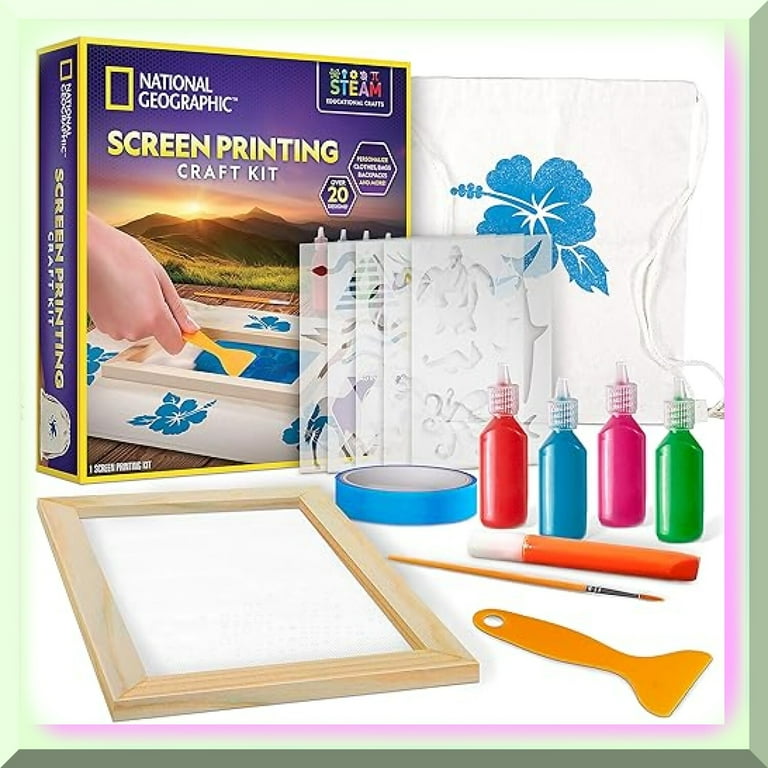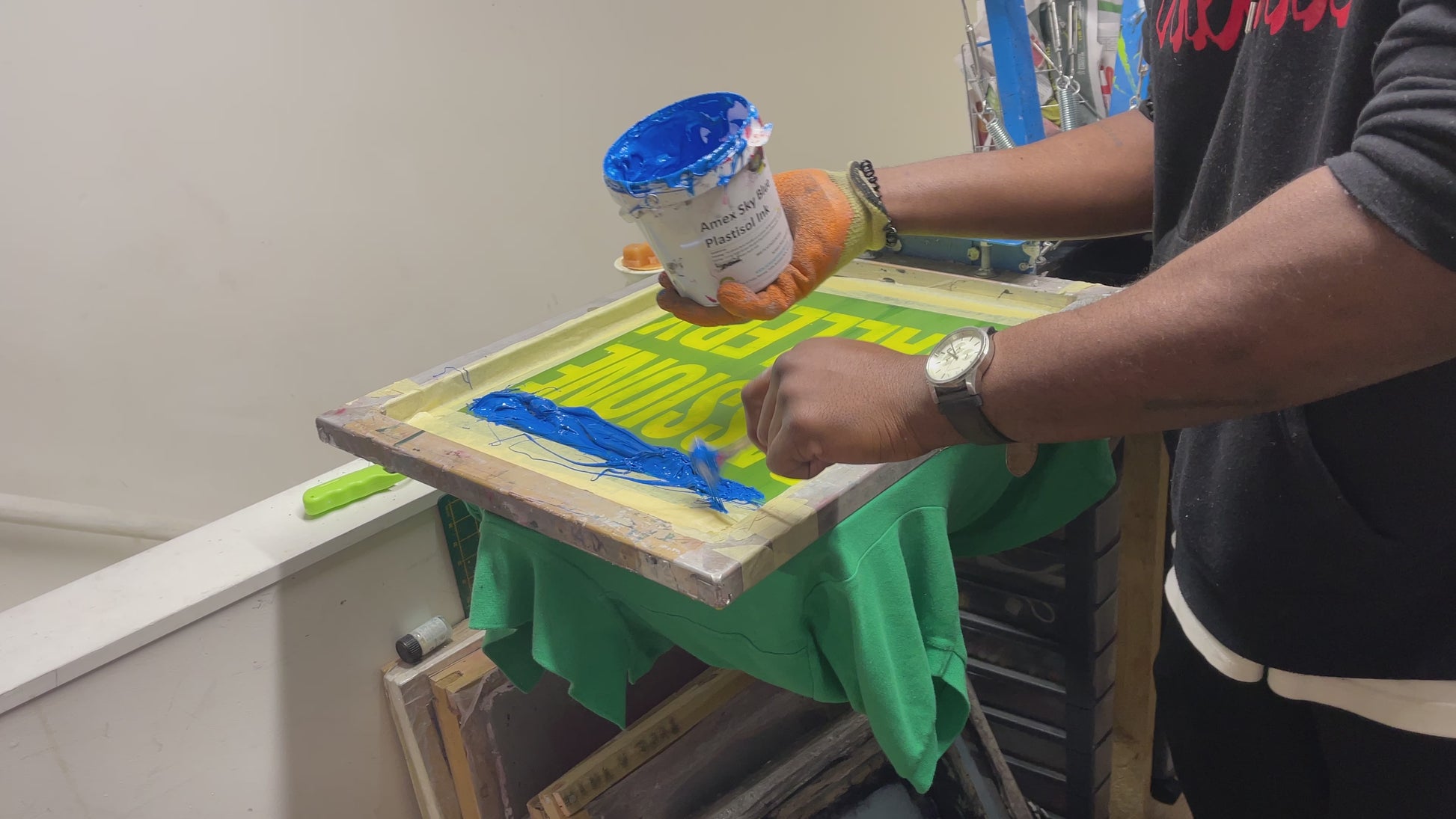Eco-Friendly Custom Screen Printing Options Available
Wiki Article
Screen Printing Uncovered: Whatever You Need to Learn About T-Shirt and Garment Printing Strategies
If you've ever wondered exactly how those vivid designs finish up on your favored t-shirts, you're in the right area. Display printing is a fascinating method that incorporates art with technique, supplying endless possibilities for imagination. Comprehending the basics, from equipment to ink choices, can substantially affect your results. Prepared to discover the vital aspects that make screen publishing an art kind? Allow's discover the details that can elevate your jobs.
The Essentials of Screen Printing: Exactly How It Works
When you plunge into display printing, you'll find it's both an art and a science. At its core, screen printing entails developing a pattern, or screen, that permits ink to pass with only in details areas (screen printing kit). You start by picking your layout and preparing your display with a light-sensitive solution. As soon as you expose this solution to light, it sets, leaving your layout as an unfavorable area.Next, you'll blend your inks and prepare your printing surface. Position the screen over the textile, then use a squeegee to push ink via the display onto the garment. This procedure requires accuracy, as you want clear, lively prints. After printing, you'll heal the ink with heat, ensuring it sticks to the textile and lasts through laundries. Each action is important, and understanding them will certainly raise your display printing skills, transforming straightforward garments into one-of-a-kind, meaningful items.
Kinds of Display Printing Methods
When you understand the basics of screen printing, it's time to discover the different strategies that can elevate your designs. One preferred technique is standard display printing, where ink is pressed via a stenciled screen. This method is fantastic for bold, dynamic shades. Then there's water-based ink printing, which provides a softer feeling and is eco-friendly, however it calls for a various strategy to healing.An additional alternative is plastisol printing, understood for its toughness and vivid colors, making it a favored for lots of brands. Experiment with halftone printing to produce gradient effects and intricate styles.
Vital Tools for Screen Printing
To attain stunning outcomes in display printing, having the ideal devices is basic. You'll require a strong screen printing framework, which holds the mesh that transfers your layout onto the garment. Next off, invest in top notch mops; these are necessary for applying ink equally across the screen.Selecting the Right Inks and Materials
When selecting inks and products for display printing, you require to take into consideration the kind of ink that works best for your project. Think of fabric compatibility to ensure your styles look last and fantastic long. Likewise, check out environment-friendly ink choices to make your printing process extra sustainable.Kinds Of Display Inks
Choosing the best screen ink is vital for attaining dynamic, sturdy prints that meet your project's requirements. There are numerous types of screen inks to analyze. Specialized inks, such as metallic or glow-in-the-dark, can add unique results to your designs.
Material Compatibility Considerations
Recognizing textile compatibility is important for achieving high-quality display prints, especially since different products react distinctively to various inks. Constantly test your inks on example fabric to guarantee they stick correctly and keep color stability. In addition, keep in mind that textile weight and texture can impact the last outcome, so picking the right ink and material combination is essential for your job's success.Eco-Friendly Ink Options
Environmentally friendly inks are coming to be a popular option for screen printers that want to decrease their environmental influence while preserving quality. When choosing inks, take into consideration water-based inks, which are much less damaging and less complicated to tidy up compared to typical solvents. These inks bond well with materials, providing dynamic outcomes without poisonous chemicals. You may likewise discover eco-solvent inks that make use of fewer unstable natural substances (VOCs), making them a safer option for both your health and wellness and the world.Additionally, look for inks made from sustainable resources, such as soy or vegetable-based choices. By selecting the best inks and products, you'll not only create stunning layouts yet likewise add to a more sustainable printing procedure. Make the button, and your prints will reflect your dedication to the setting!
Preparing Your Style for Display Printing

Submit Format Needs
To guarantee your layout looks sharp and dynamic on fabric, you'll need to pay very close attention to submit format demands for display printing. Start with vector documents like AI or EPS, as they can be scaled without shedding top quality. If you use raster pictures, decide for high-resolution files, such as TIFF or PNG, preferably at 300 DPI. Stay clear of using JPEGs, as they can lose quality when resized. Make sure your design has a clear background to prevent unwanted white sides on your prints. Maintain shade settings in mind; CMYK is standard for screen printing, so transform your RGB makes accordingly - screen printing kit. By following these guidelines, you'll set your art work up for an effective print.Color Separation Techniques
Shade splitting up is a crucial step in preparing your design for display printing, and mastering it can considerably boost your print quality. You'll require to damage your style right into check here individual shades, as each shade requires a different display throughout printing. This accuracy not only ensures accurate color representation but likewise enhances the printing procedure.Resolution and Dimension
Attaining the ideal lead to screen printing begins with guaranteeing your style has the best resolution and size. Ideally, your artwork ought to go to least 300 DPI (dots per inch) for sharp, clear prints. Your last item may look visit this page pixelated and less than professional. if you use reduced resolution.When it pertains to size, consider the dimensions of your print area. Layout your artwork to match the final print dimension, preferably developing it in the actual dimensions you'll be printing. By doing this, you'll avoid any kind of unexpected scaling problems.
Constantly examine your style in both vector and raster layouts. Vector graphics can be scaled without shedding top quality, making them ideal for display printing. Preparing correctly will ensure your design looks outstanding on every garment!
Step-by-Step Display Printing Process
Screen printing is a dynamic process that permits you to produce vibrant styles on numerous surface areas. To obtain begun, you'll need a screen, emulsion, and your chosen ink.After cleaning out the unexposed solution, your display is prepared. Establish it up on your printing surface area and align your garment underneath it. Put ink onto the display and utilize a squeegee to press the ink via the stencil onto the material. Lift the display carefully and allow the print completely dry. Lastly, heal the ink making use of warm to guarantee longevity. That's it! You've efficiently screen published your design.
Tips for Successful Display Printing Projects
While you're diving into your screen printing projects, keep in mind that preparation is essential to success. Beginning by gathering all your materials-- inks, squeegees, displays, and garments. A clean work space aids prevent undesirable errors, so neat up before you begin.Next, verify your artwork is high-resolution and effectively sized for your garment. Test your display for appropriate exposure and tidy it completely to avoid spots. When you could try these out mixing your inks, comply with the manufacturer's guidelines to accomplish the best uniformity.
Throughout printing, use also pressure with your squeegee for consistent outcomes. Do not rush; take your time to verify each print meets your requirements. After printing, let your garments completely dry totally prior to dealing with or packaging them.
Lastly, constantly maintain a sample of your benefit future recommendation. In this manner, you can evaluate your progression and boost your methods over time. Delighted printing!

Regularly Asked Concerns
How much time Does It Require To Establish a Display Printing Work?
Establishing a screen printing job typically takes about half an hour to an hour. You'll prepare the screens, mix inks, and change journalism. The moment differs based upon complexity and experience, so remain arranged!Can I Print on Different Textile Keys In Making Use Of the Very Same Method?
Yes, you can print on various textile kinds utilizing the same technique, yet you'll need to adjust your setups and inks. Some materials absorb ink differently, so exploring guarantees the ideal outcomes for every product.What Prevail Errors to Stay Clear Of in Display Printing?
When display printing, prevent common blunders like utilizing the wrong ink, disregarding correct exposure times, or skipping pre-press checks. Constantly test your arrangement and maintain tidy screens to assure high quality results each time.Exactly How Can I Appropriately Clean and Keep My Screen Printing Tools?
To correctly tidy and preserve your screen printing devices, you should routinely clean screens with ideal solvents, inspect mops for wear, and guarantee all devices are saved completely dry and dust-free. Consistency improves and protects against costly fixings performance.Is Screen Printing Eco Friendly Contrasted to Various Other Methods?
Screen printing can be extra eco-friendly than other techniques, specifically if you use water-based inks and eco-conscious products. By selecting sustainable products and practices, you minimize waste and minimize your influence on the earth.Screen Printing Uncovered: Whatever You Required to Know About T-Shirt and Garment Printing Strategies
At its core, screen printing involves producing a pattern, or screen, that allows ink to pass with only in certain areas. Position the screen over the material, then utilize a squeegee to press ink through the screen onto the garment. One popular method is conventional display printing, where ink is pressed via a stenciled display.When picking inks and materials for display printing, you need to take into account the type of ink that works best for your job.
Report this wiki page